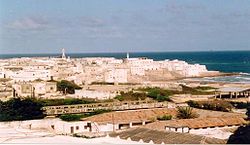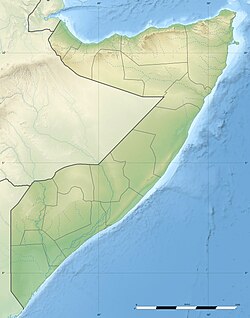| Revision as of 19:09, 10 September 2017 editAyanl3 (talk | contribs)Extended confirmed users1,137 edits Undid revision 798691835 by 145.132.195.120 (talk) stop deleting well source information and writing outsourced information that has no source at all.← Previous edit | Revision as of 19:12, 10 September 2017 edit undoAyanl3 (talk | contribs)Extended confirmed users1,137 editsNo edit summaryNext edit → | ||
| Line 64: | Line 64: | ||
| {{main article|Ajuran Sultanate|Somali aristocratic and court titles}}] and moonrise in Merca.]]Merca was established in the 7th century by the Bimaal clan. The first Somalis arrived in the city in the 6th century and gained control of the city and trade of the region.<ref>{{Cite book|url=https://books.google.nl/books?id=SQk3A-_uD88C&pg=PT119&dq=Merca+was+established+in+the+7th+century&hl=nl&sa=X&ved=0ahUKEwi3jcme78jQAhUJDcAKHaJMDaAQ6AEIGzAA#v=onepage&q=Merca%20was%20established%20in%20the%207th%20century&f=false|title=The Kaleidoscopic Lover: The Civil War in the Horn of Africa & My Itinerary for a Peaceful Lover|last=Kariye|first=Badal W.|date=2016-11-27|publisher=AuthorHouse|year=|isbn=9781452004631|location=|pages=|language=en|quote=|via=}}</ref> | {{main article|Ajuran Sultanate|Somali aristocratic and court titles}}] and moonrise in Merca.]]Merca was established in the 7th century by the Bimaal clan. The first Somalis arrived in the city in the 6th century and gained control of the city and trade of the region.<ref>{{Cite book|url=https://books.google.nl/books?id=SQk3A-_uD88C&pg=PT119&dq=Merca+was+established+in+the+7th+century&hl=nl&sa=X&ved=0ahUKEwi3jcme78jQAhUJDcAKHaJMDaAQ6AEIGzAA#v=onepage&q=Merca%20was%20established%20in%20the%207th%20century&f=false|title=The Kaleidoscopic Lover: The Civil War in the Horn of Africa & My Itinerary for a Peaceful Lover|last=Kariye|first=Badal W.|date=2016-11-27|publisher=AuthorHouse|year=|isbn=9781452004631|location=|pages=|language=en|quote=|via=}}</ref> | ||
| The 13th-century Arab geographer ] described Merca as the "capital of |
The 13th-century Arab geographer ] described Merca as the "capital of Hawiyya country". During the 12th century, the cartographer ] may have referred to the Hawiye as well, as he called Merca the region of the "Hadiye", which Herbert S. Lewis believes is a scribal error for "Hawiye", as do Guilliani, Schleicher and ].<ref>Herbert S. Lewis, "The Origins of the Galla and Somali", in ''The Journal of African History''. Cambridge University Press, 1966, pp 27–30.</ref> | ||
| During the Middle Ages, the area was one of several prominent administrative centers of the ]. The polity formed one of the largest kingdoms in the southern half of the ] region. During the Middle Ages, the Merca area was part of the ]'s realm. The polity formed one of the largest kingdoms in the southern half of the ] region. Various ]s exist in the region, which local tradition holds were built in the 16th century, when the Sultanate's ] governed the district. During the early nineteenth century] pastoralists immigrated and settled at the outskirts of Merca. | During the Middle Ages, the area was one of several prominent administrative centers of the ]. The polity formed one of the largest kingdoms in the southern half of the ] region. During the Middle Ages, the Merca area was part of the ]'s realm. The polity formed one of the largest kingdoms in the southern half of the ] region. Various ]s exist in the region, which local tradition holds were built in the 16th century, when the Sultanate's ] governed the district. During the early nineteenth century] pastoralists immigrated and settled at the outskirts of Merca. | ||
Revision as of 19:12, 10 September 2017
City in Somalia| Merca Markaمَركة | |
|---|---|
| City | |
 Merca beachside Merca beachside | |
 | |
| Coordinates: 01°41′00″N 044°45′00″E / 1.68333°N 44.75000°E / 1.68333; 44.75000 | |
| Country | |
| Region | Lower Shebelle |
| District | Merca |
| Population | |
| • Total | 192,939 |
| Time zone | UTC+3 (EAT) |
Merca (Template:Lang-so, Template:Lang-ar) is an ancient port city in the southern Lower Shebelle province of Somalia. Facing the Indian Ocean, it is the main town in the province. It is located approximately 109 km (68 mi) to the southwest of the nation's capital Mogadishu. Merca is the traditional home territory of the Bimal clan and was the center of the Bimal Revolt.
History
Main articles: Ajuran Sultanate and Somali aristocratic and court titles
Merca was established in the 7th century by the Bimaal clan. The first Somalis arrived in the city in the 6th century and gained control of the city and trade of the region.
The 13th-century Arab geographer Ibn Sa'id described Merca as the "capital of Hawiyya country". During the 12th century, the cartographer Muhammad al-Idrisi may have referred to the Hawiye as well, as he called Merca the region of the "Hadiye", which Herbert S. Lewis believes is a scribal error for "Hawiye", as do Guilliani, Schleicher and Cerulli. During the Middle Ages, the area was one of several prominent administrative centers of the Ajuran Sultanate. The polity formed one of the largest kingdoms in the southern half of the Horn region. During the Middle Ages, the Merca area was part of the Ajuran Sultanate's realm. The polity formed one of the largest kingdoms in the southern half of the Horn region. Various pillar tombs exist in the region, which local tradition holds were built in the 16th century, when the Sultanate's naa'ibs governed the district. During the early nineteenth centuryBiimaal pastoralists immigrated and settled at the outskirts of Merca.
In the 1930s a group of Italian Somalis established residency in Merca. The Port of Merca was the second in Italian Somalia and was nicknamed the "port of bananas" due to its status as a key exporter of bananas from Somalia to Europe. In the city of Merca there was a huge economical development in the 1930s, due mainly to the growing commerce of the port of Merca connected by small railway to the farm area of Genale. World War II did some damages to Merca.
Merca was abandoned by government forces and captured by Al-Shabaab in February 2016. It was recaptured by the Somali National Army along with African Union troops, a few days later. A small battle was fought in which a Somali soldier, several militants, and four civilians died.
Demographics
According to the UNDP in 2005 Merca had a population of around 192,939 inhabitants. Marka is the traditional home territory the Biimaal.
Transportation
Merca has a jetty-class seaport, the Port of Merca.
The nearest airport to the city is the K50 Airport in the Lower Shebelle province.
Art
Although visual art is not popular in Somalia due to prevailing beliefs that it contradicts Islam's proscription on all forms of idolatry, a lot of the known visual art in the country derives from the small historical town of Merca. Known for its beautiful white sandy beaches and orange dunes, the city's picturesque contrast of colors serves as an inspiration for local visual artists.
See also
Notes
- ^ http://www.landinfo.no/asset/2736/1/2736_1.pdf Marka is the traditional home territory of the Dir clan Biimaal (Lewis 2008, p. 5).
- Kariye, Badal W. (2016-11-27). The Kaleidoscopic Lover: The Civil War in the Horn of Africa & My Itinerary for a Peaceful Lover. AuthorHouse. ISBN 9781452004631.
- Herbert S. Lewis, "The Origins of the Galla and Somali", in The Journal of African History. Cambridge University Press, 1966, pp 27–30.
- Merca italiana (in Italian)
- Map of Genale (green area was the farm concessions) and Merca in the 1930s
- https://www.theguardian.com/world/2016/feb/05/al-shabaab-militants-retake-somali-port-merka-african-union
- "Somali troops 'retake' key port city of Merca from al-Shabab - BBC News". BBC News. Retrieved 2016-02-06.
- https://docs.unocha.org/sites/dms/Somalia/UNDP-POP-RURAL-URBAN%202005.pdf
- http://www.refworld.org/docid/56f399224.html
- "Istanbul conference on Somalia 21 – 23 May 2010 - Draft discussion paper for Round Table "Transport infrastructure"" (PDF). Government of Somalia. Retrieved 31 August 2013.
References
External links
- Marka Cadey - Merca web portal
- Marka News Media - homepage of people from Merca
- Osmanart - homepage of visual artist from Merca